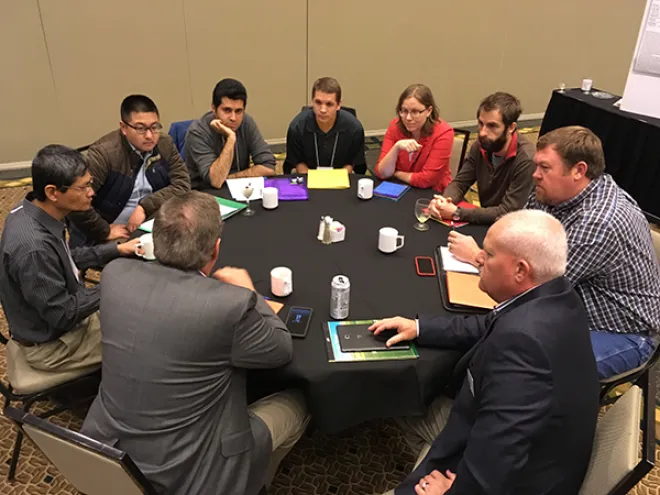Rapidly dropping reservoir levels in the West are capturing national media attention, but the nation’s underground aquifers are also under threat.
The Ogallala aquifer is one of the world’s largest fresh water resources. Communities and agriculture in eight states in the High Plains region of the country rely on it.
Ogallala Aquifer States
- Colorado
- Kansas
- Nebraska
- New Mexico
- Oklahoma
- Texas
- South Dakota
- Wyoming
Most water pumped from the Ogallala aquifer is used by agriculture, the chief driver of the region’s economy. Decades of pumping from the Ogallala aquifer continue to reduce the groundwater table faster than it can be recharged from precipitation.
Through an Agriculture and Food Research Initiative Water for Agriculture Challenge Area grant, USDA’s National Institute of Food and Agriculture (NIFA) funded a multiyear Coordinated Agriculture Project (CAP) to address the challenges faced by the Ogallala aquifer. NIFA is committed to addressing agricultural water quality and quantity needs even as it works to improve the nation’s surface and groundwater resources via climate-smart agriculture, forestry and renewable energy.

“Multiyear, multistate CAP projects like Ogallala Water funded over five years with $10 million in federal dollars allow for the development of partnerships and networks at the regional, state and local levels,” said Kevin Kephart, deputy director of NIFA’s Institute of Bioenergy, Climate and Environment. “This results in greater awareness of the issue and fosters the adoption of practical, profitable approaches to maintain an economy based on agriculture while extending the aquifer’s life.”
The project boasted a 70-member interdisciplinary team from 10 universities in six states.
The long-term goal of the Ogallala Water Coordinated Agriculture Project focused on ways to optimize the use of groundwater to support food production and rural communities.
Jim Dobrowolski, national program leader for NIFA’s Division of Environmental Systems, said Ogallala Water was laser-focused on extending the aquifer’s utility for irrigated agriculture.
“They spent five years working towards a solution to what many people consider the greatest management challenge in the nation today,” he added.
According to Dobrowolski, the project’s partnership with local, state, and federal agencies—including USDA’s Natural Resources Conservation Service (NRCS) and Agricultural Research Service (ARS)— contributed to its overall success.
“Ogallala Water cooperated with USDA-NRCS’s Ogallala Aquifer Initiative and USDA-ARS’s collaborative Ogallala Aquifer Program with Texas A&M University, along with state water agencies, local water and irrigation districts, and farmers,” Dobrowolski said. “The team improved understanding about how to manage water to be successful at achieving voluntary and mandatory water use goals through multidisciplinary field research and outreach programs, as well as by studying farmers decisions and outcomes.”
Colorado State University (CSU) scientist Meagan Schipanski, who served as the project leader, said the Ogallala Water CAP built new collaborations across institutions and disciplines.

“Our team made important research discoveries at the individual producer level, regional level and multistate level,” she said. “For example, the group made improvements to freely available irrigation scheduling tools by integrating soil moisture sensors and short-term weather forecast data to improve water use efficiency. At the regional level, the team developed MOD$$AT, a modeling program that can evaluate potential hydrologic and economic impacts of real-world policy and management scenarios.”
Learn more about MOD$$AT and how it is helping farmers make better irrigation decisions here.
In addition to their research efforts, the Ogallala Water CAP team ensured their research reached producers and others through Extension outreach efforts.
The team supported the development of new — and expanded the use of — innovative programs, including Master Irrigator and Testing Ag Performance Solutions (TAPS). These tools are influencing management decisions on hundreds of thousands of acres in the High Plains. A multistate network of Extension professionals was formed to share successes and challenges in groundwater-dependent areas of the High Plains, California, and the Mississippi Delta region. Additionally, two summits led by the team in 2018 and 2021 forged strong diverse stakeholder networks of individuals and groups working across the region that are learning from each other’s success in encouraging improved water management.
Schipanski’s CSU colleague, Amy Kremen, said the team’s work has been critically important to finding ways to address the challenges facing the Ogallala aquifer.
“The Ogallala Water CAP team has identified how water managers in this semi-arid production area can benefit from flexible state policies and access to state and federal programs that reward groundwater stewardship,” said Kremen. “Some possibilities include voluntary collective commitments to limit pumping, new limited irrigation crop insurance options, and programs that help producers prioritize profitability and water use productivity over maximizing yield.”
Schipanski and Kremen agree that commitments from individual producers, as well as state and federal policymakers, are needed to extend the life of the aquifer while supporting agriculture and rural communities in the High Plains.
Top photo: Aerial view of irrigated and non-irrigated fields in eastern Colorado. Photo by Bill Cotton, Colorado State University.

